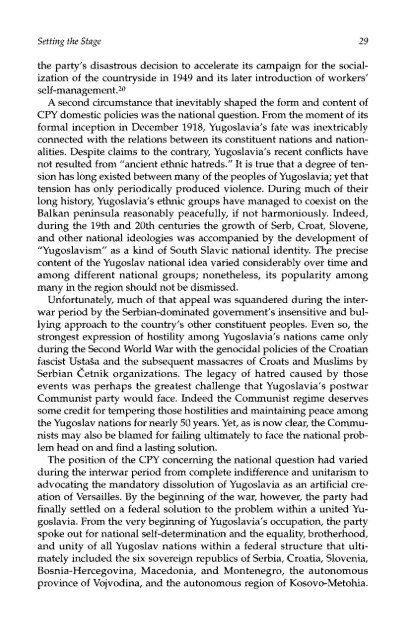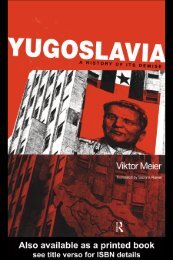Part Two - Indymedia
Part Two - Indymedia
Part Two - Indymedia
You also want an ePaper? Increase the reach of your titles
YUMPU automatically turns print PDFs into web optimized ePapers that Google loves.
Setting the Stage 29<br />
the party's disastrous decision to accelerate its campaign for the socialization<br />
of the countryside in 1949 and its later introduction of workers'<br />
self-management. 20<br />
A second circumstance that inevitably shaped the form and content of<br />
CPY domestic policies was the national question. From the moment of its<br />
formal inception in December 1918, Yugoslavia's fate was inextricably<br />
connected with the relations between its constituent nations and nationalities.<br />
Despite claims to the contrary, Yugoslavia's recent conflicts have<br />
not resulted from "ancient ethnic hatreds." It is true that a degree of tension<br />
has long existed between many of the peoples of Yugoslavia; yet that<br />
tension has only periodically produced violence. During much of their<br />
long history, Yugoslavia's ethnic groups have managed to coexist on the<br />
Balkan peninsula reasonably peacefully, if not harmoniously. Indeed,<br />
during the 19th and 20th centuries the growth of Serb, Croat, Slovene,<br />
and other national ideologies was accompanied by the development of<br />
"Yugoslavism" as a kind of South Slavic national identity. The precise<br />
content of the Yugoslav national idea varied considerably over time and<br />
among different national groups; nonetheless, its popularity among<br />
many in the region should not be dismissed.<br />
Unfortunately, much of that appeal was squandered during the interwar<br />
period by the Serbian-dominated government's insensitive and bullying<br />
approach to the country's other constituent peoples. Even so, the<br />
strongest expression of hostility among Yugoslavia's nations came only<br />
during the Second World War with the genocidal policies of the Croatian<br />
fascist UstaSa and the subsequent massacres of Croats and Muslims by<br />
Serbian Cetnik organizations. The legacy of hatred caused by those<br />
events was perhaps the greatest challenge that Yugoslavia's postwar<br />
Communist party would face. Indeed the Communist regime deserves<br />
some credit for tempering those hostilities and maintaining peace among<br />
the Yugoslav nations for nearly 50 years. Yet, as is now clear, the Communists<br />
may also be blamed for failing ultimately to face the national problem<br />
head on and find a lasting solution.<br />
The position of the CPY concerning the national question had varied<br />
during the interwar period from complete indifference and unitarism to<br />
advocating the mandatory dissolution of Yugoslavia as an artificial creation<br />
of Versailles. By the beginning of the war, however, the party had<br />
finally settled on a federal solution to the problem within a united Yugoslavia.<br />
From the very beginning of Yugoslavia's occupation, the party<br />
spoke out for national self-determination and the equality, brotherhood,<br />
and unity of all Yugoslav nations within a federal structure that ultimately<br />
included the six sovereign republics of Serbia, Croatia, Slovenia,<br />
Bosnia-Hercegovina, Macedonia, and Montenegro, the autonomous<br />
province of Vojvodina, and the autonomous region of Kosovo-Metohia.
















